Plot
Aboard a private aircraft, Dr. Gropinger (Ron Moody)—a parody of Henry Kissinger—is on a goodwill tour of Middle Eastern countries. He misplaces his diary and is thrown into a panic as, without the diary, he no longer knows what country he is about to land in. Stepping off the plane, he extends greetings in Hebrew to a congregation of Arabs and is shot dead. Soon after, the U.S. President (Joss Ackland, in a caricature of Gerald Ford) receives a threatening letter claiming responsibility for the death, signed "Moriarty", who claims to have set in motion a plan that will allow him to rule the world. The president dispatches a top agent to London to work with the world's top law enforcement officials and find a strategy to combat Moriarty.
Headed by an incompetent Englishman (Denholm Elliott), the committee settles on contacting Arthur Sherlock Holmes (John Cleese), an eccentric private detective with an affinity for certain addictive drugs (a nod to the literary Sherlock Holmes' experience with cocaine). Holmes is entrusted by the Commissioner of Police (Stratford Johns) to find the descendant of Moriarty before he gains control of the world, accompanied by the descendant of Dr. Watson (Arthur Lowe), who is both a medical doctor and utter fool. The commissioner is murdered while trying to leave, his death mainly the result of Watson's rampant stupidity.
The duo then proceed to Scotland Yard to discuss the situation with the committee. Before any plans can be made, most of the committee members are murdered by a sniper. Without their help, Holmes concocts a plan to invite the world's great detectives to a party, with the hope of laying a trap for Moriarty, who will be unable to pass up a chance at attacking all of them at once. Many fictional detectives attend, including Sam Spade, Columbo, and Hercule Poirot, all of whom are dispatched while Holmes and Watson do a crossword. The murderer is revealed to an exact doppelgänger of Watson, leading to great confusion when Holmes cannot determine who is the real Watson, particularly when Watson himself is too stupid to know which is which.
After some clever deduction, Holmes discovers who the real Watson is, and the doppelgänger is revealed to be Moriarty's grandchild, who is in fact Holmes' landlady Mrs. Hudson (Connie Booth). Holding Holmes and Watson at gunpoint, she tells them of her long-simmering plan to avenge her grandfather's death by destroying civilization. She shoots Dr. Watson and proceeds to riddle Holmes with (an impossible number of) bullets, which he survives, revealing he suspected her all along and so asked Watson to load her gun with blanks. As Holmes gloats, Watson sheepishly tells him that he forgot to switch the bullets; Holmes realizes he's been shot for real, and dies.

Hercule Poirot is a fictional Belgian detective created by British writer Agatha Christie. Poirot is one of Christie's most famous and long-running characters, appearing in 33 novels, two plays, and more than 50 short stories published between 1920 and 1975.
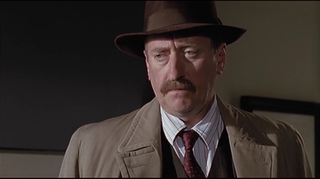
Inspector James Japp is a fictional character who appears in several of Agatha Christie's novels featuring Hercule Poirot.
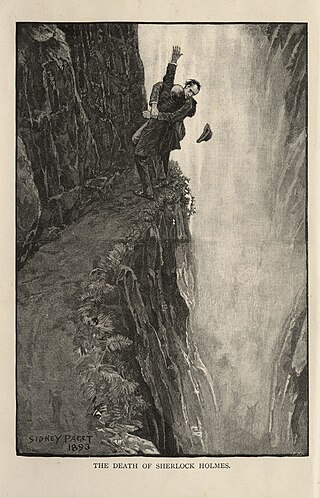
"The Final Problem" is a short story by Sir Arthur Conan Doyle featuring his detective character Sherlock Holmes. It was first published in The Strand Magazine in the United Kingdom, and McClure's in the United States, under the title "The Adventure of the Final Problem" in December 1893. It appears in book form as part of the collection The Memoirs of Sherlock Holmes.
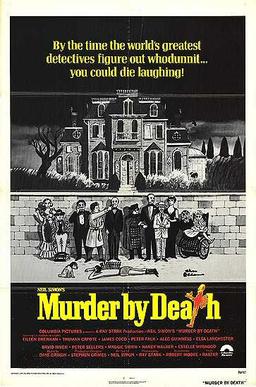
Murder by Death is a 1976 American comedy mystery film directed by Robert Moore and written by Neil Simon. The film stars Eileen Brennan, Truman Capote, James Coco, Peter Falk, Alec Guinness, Elsa Lanchester, David Niven, Peter Sellers, Maggie Smith, Nancy Walker, and Estelle Winwood.

Detective Inspector G. Lestrade, or Mr. Lestrade, is a fictional character appearing in several of the Sherlock Holmes stories written by Arthur Conan Doyle. Lestrade's first appearance was in the first Sherlock Holmes story, the novel A Study in Scarlet, which was published in 1887. The last story in which he appears is the short story "The Adventure of the Three Garridebs", which was first published in 1924 and was included in the final collection of Sherlock Holmes stories by Doyle, The Case-Book of Sherlock Holmes.
The stories of Sherlock Holmes by Sir Arthur Conan Doyle have been very popular as adaptations for the stage, and later film, and still later television. The four volumes of the Universal Sherlock Holmes (1995) compiled by Ronald B. De Waal lists over 25,000 Holmes-related productions and products. They include the original writings, "together with the translations of these tales into sixty-three languages, plus Braille and shorthand, the writings about the Writings or higher criticism, writings about Sherlockians and their societies, memorials and memorabilia, games, puzzles and quizzes, phonograph records, audio and video tapes, compact discs, laser discs, ballets, films, musicals, operettas, oratorios, plays, radio and television programs, parodies and pastiches, children's books, cartoons, comics, and a multitude of other items — from advertisements to wine — that have accumulated throughout the world on the two most famous characters in literature."

Sherlock Holmes has long been a popular character for pastiche, Holmes-related work by authors and creators other than Arthur Conan Doyle. Their works can be grouped into four broad categories:
Many writers make references to Sir Arthur Conan Doyle's famous literary creation, the detective Sherlock Holmes, and these often become embedded within popular culture. While Holmes exists predominantly in the context of Victorian-era London, he has been mentioned in such outre contexts as the 22nd century or hunting aliens or supernatural enemies. These references are in addition to the innumerable passing references to Sherlock Holmes made in many literary and cinematic works, such as the labeling of a person as a "Sherlock", whether in reference to their intelligence.

The Adventures of Sherlock Holmes is a 1939 American mystery adventure film based on Sir Arthur Conan Doyle's Sherlock Holmes detective stories. Although claiming to be an adaptation of the 1899 play Sherlock Holmes by William Gillette, the film bears little resemblance to the play.
Incident at Victoria Falls is the 1992 sequel to Sherlock Holmes and the Leading Lady, and the second and final film in the proposed series of television films Sherlock Holmes the Golden Years written by Bob Shayne. It starred Christopher Lee and Patrick Macnee as Holmes and Watson in old age.
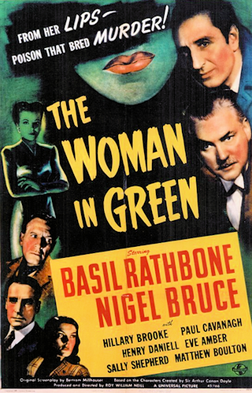
The Woman in Green is a 1945 American film, the eleventh of the fourteen Sherlock Holmes films based on the characters created by Arthur Conan Doyle. Produced and directed by Roy William Neill, it stars Basil Rathbone as Sherlock Holmes and Nigel Bruce as Dr. Watson, with Hillary Brooke as the woman of the title and Henry Daniell as Professor Moriarty. The film follows an original premise with material taken from "The Final Problem" (1893) and "The Adventure of the Empty House" (1903).

Sherlock Holmes and the Secret Weapon (1942) is the fourth in the Basil Rathbone/Nigel Bruce series of 14 Sherlock Holmes films which updated the characters created by Sir Arthur Conan Doyle to the then present day. The film is credited as an adaptation of Conan Doyle's 1903 short story "The Adventure of the Dancing Men," though the only element from the source material is the dancing men code. Rather, it is a spy film taking place on the background of the then ongoing Second World War with an original premise. The film concerns the kidnapping of a Swiss scientist by their nemesis Professor Moriarty, to steal a new bomb sight and sell it to Nazi Germany. Sherlock Holmes and Dr. John Watson have to crack a secret code in order to save the country.

Silver Blaze is a 1937 British, black-and-white crime and mystery film, based loosely on Arthur Conan Doyle's 1892 short story "The Adventure of Silver Blaze". It was directed by Thomas Bentley, and was produced by Twickenham Film Studios Productions. It stars Arthur Wontner as Sherlock Holmes, and Ian Fleming as Dr. Watson. In the United States, the film was released in 1941 by Astor Pictures, where it was also known as Murder at the Baskervilles, retitled by distributors to capitalize on the success of the Basil Rathbone Holmes film, The Hound of the Baskervilles.

The Triumph of Sherlock Holmes is a 1935 British mystery film directed by Leslie S. Hiscott and starring Arthur Wontner. It was based on the 1915 Sherlock Holmes novel The Valley of Fear by Arthur Conan Doyle.

The Hound of the Baskervilles is a 1983 British made-for-television mystery thriller film directed by Douglas Hickox, starring Ian Richardson as Sherlock Holmes and Donald Churchill as Dr. John H. Watson. It is based on Arthur Conan Doyle's 1902 novel The Hound of the Baskervilles.
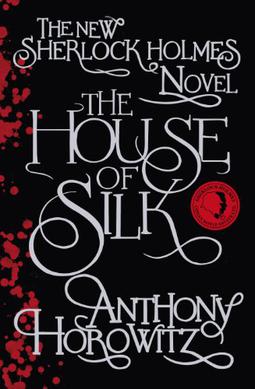
The House of Silk is a Sherlock Holmes novel written by British author Anthony Horowitz, published in 2011. The book was promoted with the claim it was the first time the Conan Doyle Estate had authorised a new novel that is not a Sherlock Holmes pastiche.

Fictional detectives are characters in detective fiction. These individuals have long been a staple of detective mystery crime fiction, particularly in detective novels and short stories. Much of early detective fiction was written during the "Golden Age of Detective Fiction" (1920s–1930s). These detectives include amateurs, private investigators and professional policemen. They are often popularized as individual characters rather than parts of the fictional work in which they appear. Stories involving individual detectives are well-suited to dramatic presentation, resulting in many popular theatre, television, and film characters.

Sherlock in Russia is a Russian detective TV series based on Arthur Conan Doyle's stories about the legendary detective Sherlock Holmes. This is the third Russian adaptation of the character and the first with original script. The series was released in October 2020 on the Start.ru streaming service.















